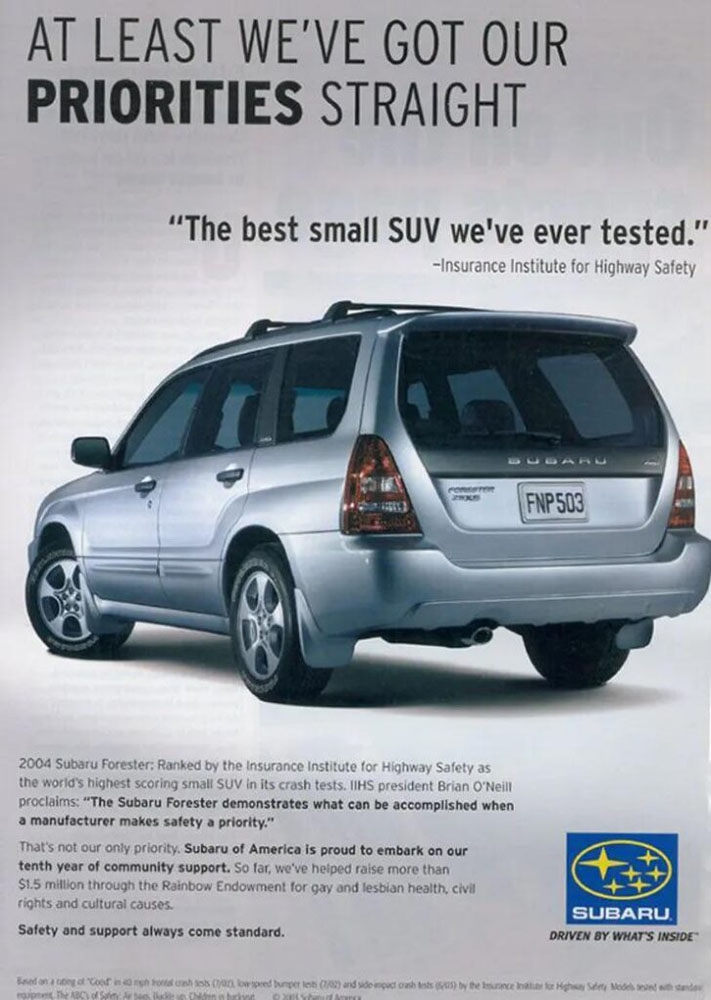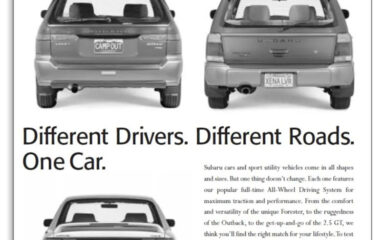
It’s the mid-‘90s. Subaru is struggling to boost declining revenue after their previous attempt (a luxury car and a stupidly ironic ad campaign — don’t ask) failed dramatically. They’ve just ditched their agency and are back to answering the big question: How do you compete with bigger, flashier, sexier car brands like Toyota and Nissan?
Well, you start with a market that already thinks you’re sexy.
Subaru’s marketing team threw their focus into figuring out who did like the brand. Through market research, they identified four core audiences to target, and then… a fifth? Their data indicated areas like Northampton, Massachusetts, and Portland, Oregon were particular hotspots where the head of household would often be a single person — and often a woman. And now they had some suspicions to explore.
They brought in Mulryan/Nash — an agency that specializes in LGBTQ audiences — to confirm they were headed in the right direction. And when the agency went out to Northampton for their first focus group with Subaru owners? Only women showed up — women who liked, say, camping, and wanted room for their dog. All evidence indicated that the women loved the outdoors, their Subaru, and probably other women. The agency made the pitch, the president liked it, and now Subaru was advertising to lesbians.
Mid-90s: “Gay Vague”
The trick to running lesbian-focused ads in the era of Don’t Ask Don’t Tell and the Defense of Marriage Act? Ads that “aren’t about lesbians.” Mulryan/Nash created the Magic Eye painting of the ad world: a campaign for, like, “outdoorsy people” (wink) full of such nuance the lesbian community instantly knew it was for them.
And while the agency did test ads showing actual women, their market liked the winks and nudges. (It was called “gay vague.”) The decoding of the ads was part of the fun. And who wouldn’t like that, when it results in ads like this one?

The average viewer might see the print ad and think ooh, check out the versatility of this car here. Queer audiences are going to check out the license plates: CAMP OUT, as in camping and, y’know, out; XENA LVR, in honor of the arguably lesbian warrior princess who launched a thousand sexual awakenings; and P TOWNIE, in honor of LGBTQ enclave Provincetown, Massachusetts, which I personally didn’t know but outdoorsy lesbians arguably might. Subaru was talking to people who didn’t get talked to, and getting it right.
Early ‘00s: Out and Proud
By the early 2000s, Subaru was essentially out of the closet, and the subtext was growing into text. In 2001, the brand brought in tennis legend Martina Navratilova as its spokesperson. Navratilova was (and still is) openly lesbian and a proponent of LGBTQ rights, but in this campaign, she was “just a girl” talking about performance and control and grip along with golfers Juli Inkster and Meg Mallon and skier Diann Roffe-Steinrotter — all pro athletes who happen to also be strongly admired by lesbians.
Navratilova appeared on commercials, in print ads, on billboards. And when the campaign started getting pushback, angry letters, threats of boycott, they did absolutely nothing, and one year in, Subaru was having their best sales year to date. In 2004, they even had a Subaru-centric storyline — a lesbian tennis player getting an endorsement deal from Subaru, naturally — on The L Word. Increasingly, the niche was going mainstream. The lesbian core audience was one of the most successful ones the company had targeted, and by 2006, revenue was stabilized and on the rise.
Subaru has, you might have noticed, moved away from targeting lesbians specifically — as society in general has become more inclusive, the niche has somewhat un-niched itself. But even as the brand has pivoted to more activity- and interest-focused ads, the association, and the affinity, remain.
Mid-’20s: Happy Pride, Y’all

One of the big reasons the campaign worked for a good decade was the sincerity behind it. Anyone can slap a rainbow on an ad and put a couple of same-sex couples in a campaign that runs from June 1 to June 30 — Subaru was in it back before it was widely accepted, speaking a language their market wasn’t used to hearing from major brands. The subtle, careful nuance itself is what made them feel seen.
That said, the queercoded campaign might have played differently had Subaru not put its money where its mouth was. As subtle as the ads themselves were, Subaru never tried to hide its support of the community, donating millions to HIV research, donating to the Human Rights Campaign, sponsoring Pride parades, and partnering with numerous organizations and charities. And so what otherwise might have seemed like glib stereotyping — they did everything short of showing a Forrester towing a U-Haul — instead came across as the affectionate inside joke it legitimately was.
And now you know why lesbians love Subarus.
Happy Pride Month to all my letters out there, in or out, no matter what you drive. (I don’t know the vehicle of choice for G’s and T’s. For B’s, it’s obviously crossovers.) May your pride be deservedly prideful, and may it last well past June 30.
(Hat tip to Priceonomics, Planet Money, The Daily Dave, and Marketing the Rainbow for pertinent details and insightful insights.)

